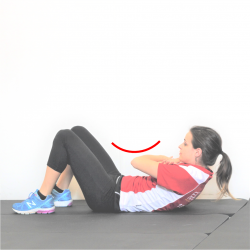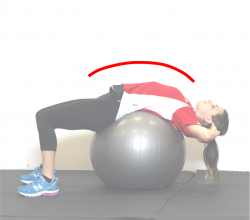Crunch
A crunch is an important movement to master because it is used regularly when changing body positions and moving around in daily life; the muscles involved in a crunch are crucial for maintaining core strength, stability and correct posture. There is always debate about crunches being effective, however I believe that a crunch is an important foundational exercise to master before progressing to any of the more challenging ab exercises because to do it correctly requires the pelvis to be properly positioned, the body to be stabilised and all of the core muscles to be engaged. This teaches good body awareness and trains for good posture.
A crunch on a Swiss ball is a great version of a crunch because it requires extra stability to maintain balance, and also allows a larger range of movement than you can achieve on the floor. It may also be slightly easier to get into position because you don’t have to get all the way down on the floor – which can be challenging for some people.
The perfect crunch

- Lie in a comfortable position on the floor with knees bent
- Your feet should be about hip width apart and flat on the floor – NOT hooked under anything or pressed against a wall as this causes over use of hip flexors.
- With your hands either on your chest (easier) or behind your head (harder), pull your belly button in towards your spine and tilt the pelvis backwards, flattening out the lower back and engaging all the core muscles.
- Slowly curl up lifting one vertebra at a time up off the floor, your torso makes a ‘C’ shape, and the movement is being generated from the abdominal muscles, not the hip flexors.
- Stop before you come ALL the way up to a sitting position, to keep the muscles engaged throughout the range of motion.
- Slowly lower back down to your starting position
Common mistakes
Back arches, pelvis tilts forwardBecause of our tendency to have anteriorly tilted pelvis, tight hip flexors and lower back muscles, we have a tendency to have the low back arched during abdominal exercises. This places excessive stress on the lower spine, and prevents the abdominal muscles from correctly engaging. The first and most important step in mastering the perfect crunch, is proper pelvic position. We need to tuck the pelvis under – tilting it backwards, tightening the abdominals and slightly rounding the lower back. You can test this by lying flat on the floor with knees bent. See if you can slide your hand under your lower back. In order to tilt the pelvis backwards and engage the abdominals you will need to press the lower back flat to the floor so that you can no longer slide your hand underneath. |
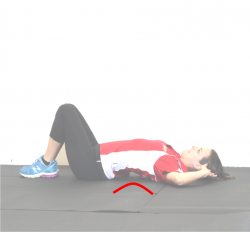 |
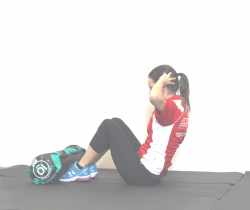 |
Hooking feet under somethingWhen we hook our feet underneath something, or someone holds our feet down for us, it causes us to use the hip flexors much more than the abdominals. As mentioned, the hip flexors tend to be tight, and they are a powerful group of muscles that cross the front of the hip, so they pull the hips towards the torso, while the abs are involved in flexing or ‘curling’ the spine forwards. In order to really focus effort on the abdominal muscles we must first keep the pelvis the right position, and then focus on ‘curling’ our body up slowly, rather than pulling ourselves us from the hips. |
Using momentum, doing full sit upsFlinging ourselves up into a sit up from the hips relies heavily on the already over-tight hip flexor muscles rather than the abdominals, and using momentum also reduces the amount of tension on the muscle, and ‘cheats’ by using assistance from the hips and arms throwing their weight forwards. You’re better of doing slow, and smaller range of movement crunches, rather than throwing yourself up into a full sit up. |
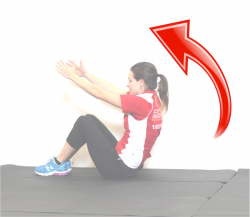 |
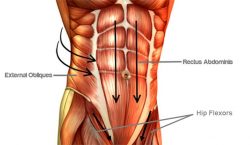 |
Only using the ‘power’ muscles not the ‘stabiliser’ musclesThis one is similar to the other issues listed above. If we are not properly positioning the pelvis and holding our body in alignment, the shallow ‘power’ muscles do most of the work, and the deeper ‘stabiliser’ muscles are neglected. In order to properly train all of our core muscles we will need to do a variety of movements including twisting, bending, balance and stability exercises, but when we are doing a crunch, keep focused on proper form to keep the stabilisers involved. |
Hyperextending over a fitballIf you’re crunching on a fit ball, you need to stop when your body is in a straight line from your hips to your shoulders in order to maintain and tucked pelvis and engaged deep core muscles. If you hyperextend your spine (bending backwards over the ball) you stretch your abdominal muscles and cause your pelvis to come out of proper alignment. When you place the muscle under tension from this stretched position as you try to sit back up, you put yourself at a higher risk of injury. |
|

